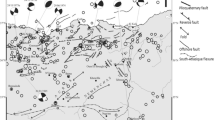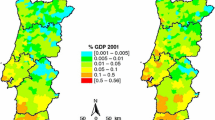Abstract
This is the second part of our study on the assessment of seismic hazard and seismic risk for Tulbagh, the settlement, located about 90 km N-E from Cape Town, where the strongest and most damaging earthquake known in the existing earthquake history of South Africa took place. This part of our study, which can be read independently from Part I, concentrates on the probabilistic seismic risk analysis (PSRA) forTulbagh. The work begins with an introduction and a historical perspective on the estimation of seismic damage to buildings. The methodology for the estimation of expected damage from a probabilistic point of view is then presented. The work closes with an application of the described methodology to a site in the vicinity of Tulbagh.
Similar content being viewed by others
References
Algermissen, S. T., Reinehart, W., Dewey, J., Steinbrugge, K. W., Lagorio, H. J., Degenkob, H. J., Cluff, L. S., McClure, F. E., Scott, S., and Gordon, R. F.: 1972, A study of earthquake losses in the San Francisco Bay Area: Data and analysis. Washington, D.C. National Oceanic and Atmospheric Administration (NOAA).
Assessment of the State-of-the-Art Earthquake Loss EstimationMethodologies: 1994, Federal Emergency Management Agency, FEMA-249/June 1994, Earthquake Hazard Reduction Series 70, 300 pp.
ATC-13: 1985, Earthquake Damage Evaluation Data for California, Applied Technology Council, Redwood City, CA.
Bramerini, F., Di Pascale, G., Orsini, G., Pugliese, A., Romeo, R. and Sabetta, F.: 1995, Seismic risk in territory of Italy (in Italian), Proceedings of 7th Convegno Nazionale di Ingegneria Sismica, Siena, Italy, September 25–28.
Cao, T., Petersen, M. D., Cramer, C. H., Toppozada, T. R., Reichle, M. S., and Dawis, J. F.: 1999, The calculation of expected loss using probabilistic seismic hazard analysis, Bull. Seism. Soc. Am. 89, 867–876.
Chen, Q., Chen, Y., Liu, J., and Chen, L.: 1997, Quick and approximate estimation of earthquake loss based on macroseismic index of exposure population, Natural Hazards 15, 217–229.
Cornell, C. A.: 1989, Probabilistic analysis of damage to structures under seismic loads, In: A. S. Cakmak and I. Herrera (eds), Structural Dynamics and Soil Structure Interaction, Computational Mechanics Publications, England.
D'Ayala, D., Spence, R., and Oliveira, C.: 1997, Earthquake loss estimation for Europe's historic town centres, Earthquake Spectra 13, 773-793.
Dowrick, D. and Rhoades, D. A.: 1990, Damage ratios for domestic buildings in the 1987 Edgecumbe earthquake, Bulletin of the New Zealand National Society for Earthquake Engineering 23(2), June.
Dowrick, D. and Rhoades, D. A.: 1993, Damage costs for commercial and industrial property as a function of intensity in the 1987 Edgecumbe earthquake, Earthquake and Structural Damage 22, 869–884.
Freeman, J. R.: 1932, Earthquake Damage and Earthquake Insurance, McGraw-Hill, New York.
Keilis-Borok, V. I., Kronrod, T. L., and Molchan, G. M.: 1984, Seismic risk for the largest cities of the World: Intensity VIII and more, Geneva Papers on Risk and Insurance 9, 255–270.
Kunreuther, H. and Roth, R. J. (eds): 1998, Paying the Price. The Status and Role of Insurance against Natural Disasters in the United States Joseph Henry Press, Washington, D.C.
Kijko, A. and Graham G.: 1999, “Parametric-Historic” procedure for probabilistic seismic hazard analysis. Part II: Assessment of seismic hazard at specified site, Pure Appl. Geophys 154, 1–22.
Kijko, A. and Retief, S. J. P.: 2001, Seismic Risk Assessment for the Cresta Zones, Council for Geoscience internal report no. 2001-0103.
Kijko, A., Retief, S. J. P., and Graham, G.: 2001, Seismic Hazard and Risk Assessment for Tulbagh, South Africa: Part I. Assessment of Seismic Hazard, Natural Hazards 26, 175–201.
McCormack, T. C. and Rad, F. N.: 1997, An earthquake loss estimation methodology for buildings based on ATC-13 and ATC-21, Earthquake Spectra 13, 605–642.
McGuire, R. K.: 1993, Computations of seismic hazard, Annali Di Geofisica 36, 181–200.
Orsini, G.: 1999, A model for buildings' vulnerability assessment using the parameterless scale of seismic intensity, Earthquake Spectra 15, 463–483
Panel on Earthquake Loss Estimation Methodology, Committee on Earthquake Engineering, Commission on Engineering and Technical Systems, National Research Council: 1989, Estimating Losses From Future Earthquakes. Panel Report, National Academy Press, Washington, D.C., 82 pp.
Reitherman, R.: 1985, A review of Earthquake Damage Estimation Methodologies, Earthquake Spectra, EERI 1, 805–847.
Rojahn, C., King, S. A., Scholl, R. E., Kiremidjian, A. S., Reaveley, L. D., and Wilson, R. R.: 1997, Earthquake Damage and Loss Estimation Methodology and Data for Salt Lake County, Utah (ATC-36).
Shojgu, S. K., Shakhramanjyan, M. A., Koff, G. L., Kenzhebaev, E. T., Larionov, V. I., and Nigmetov, G. M.: 1992, Seismic Risk Analysis, Population Rescue and Life Support During Catastrophic Earthquakes (Seismological, Methodological and Systematic Aspects). Moscow, State Committee of Russian Federation on Civil Defence and Emergency Situations.
Steinbrugge, K. V.: 1982, Earthquake, Volcanoes, and Tsunamis: An Anatomy of Hazard, Skandia America Group, New York.
Steinbrugge, K. V., Algermissen, S. T., and Lagorio, H. J.: 1984, Determining monetary losses and casualties for use in earthquake mitigation and disaster response planning. Proceedings of the Eighth World Conference on Earthquake Engineering. El Cerrito, California: Earthquake Engineering Research Institute.
Thiel, C. C. and Zsutty, T. C.: 1987, Earthquake characteristics and damage statistics, Earthquake Spectra 3(4), 747–792.
Trifunac, M. D. and Brady, A. G.: 1975, On the correlation of seismic intensity scales with the peaks of recorded ground motion, Bull. Seism. Soc. Am. 65, 139–162.
Wald, J. W., Quitoriano, V., Heaoton, T. H., and Kanamori, H.: 1999, Relationship between Peak Ground Acceleration, Peak Ground Velocity, and Modified Mercalli Intensity in California, Earthquake Spectra 15, 557–564.
Walpole, R. E. and Myers, R. H.: 1985, Probability and Statistics for Engineers and Scientists. Forth Edition. Macmillan Publishing Company, New York.
Whitman, R.V., Reed, J. W., and Hong, S. T.: 1973, Earthquake Damage Probability Matrices, Proceedings of the Fifth World Conference on Earthquake Engineering.
Whitman, R. V.: 1986, Earthquake Loss Estimation Methodology, In: A Vogel and K. Brandes (eds), Earthquake Prognostics, Hazard Assessment, Risk Evaluation and Damage Prevention, Proceedings from the 2nd International Seminar held in Berlin, June 24–27. Friedr. Vieweg & Sohn, Braunschweig/Wiesbaden, pp. 259–278.
Yong, C., Qifu, C., and Ling, C.: 1998, Vulnerability analysis in earthquake loss estimate, Earthquake Research in China 12, 331–339.
Author information
Authors and Affiliations
Rights and permissions
About this article
Cite this article
Kijko, A., Retief, S.J.P. & Graham, G. Seismic Hazard and Risk Assessment for Tulbagh, South Africa: Part II – Assessment of Seismic Risk. Natural Hazards 30, 25–41 (2003). https://doi.org/10.1023/A:1025036409750
Issue Date:
DOI: https://doi.org/10.1023/A:1025036409750




